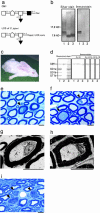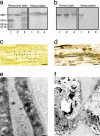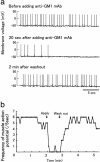Carbohydrate mimicry between human ganglioside GM1 and Campylobacter jejuni lipooligosaccharide causes Guillain-Barre syndrome
- PMID: 15277677
- PMCID: PMC509213
- DOI: 10.1073/pnas.0402391101
Carbohydrate mimicry between human ganglioside GM1 and Campylobacter jejuni lipooligosaccharide causes Guillain-Barre syndrome
Abstract
Molecular mimicry between microbial and self-components is postulated as the mechanism that accounts for the antigen and tissue specificity of immune responses in postinfectious autoimmune diseases. Little direct evidence exists, and research in this area has focused principally on T cell-mediated, antipeptide responses, rather than on humoral responses to carbohydrate structures. Guillain-Barré syndrome, the most frequent cause of acute neuromuscular paralysis, occurs 1-2 wk after various infections, in particular, Campylobacter jejuni enteritis. Carbohydrate mimicry [Galbeta1-3GalNAcbeta1-4(NeuAcalpha2-3)Galbeta1-] between the bacterial lipooligosaccharide and human GM1 ganglioside is seen as having relevance to the pathogenesis of Guillain-Barré syndrome, and conclusive evidence is reported here. On sensitization with C. jejuni lipooligosaccharide, rabbits developed anti-GM1 IgG antibody and flaccid limb weakness. Paralyzed rabbits had pathological changes in their peripheral nerves identical with those present in Guillain-Barré syndrome. Immunization of mice with the lipooligosaccharide generated a mAb that reacted with GM1 and bound to human peripheral nerves. The mAb and anti-GM1 IgG from patients with Guillain-Barré syndrome did not induce paralysis but blocked muscle action potentials in a muscle-spinal cord coculture, indicating that anti-GM1 antibody can cause muscle weakness. These findings show that carbohydrate mimicry is an important cause of autoimmune neuropathy.
Figures



References
-
- Marrack, P. J. & Kotzin, B. L. (2001) Nat. Med. 7, 899–905. - PubMed
-
- Yuki, N. (2001) Lancet Infect. Dis. 1, 29–37. - PubMed
-
- McKhann, G. M., Cornblath, D. R., Griffin, J. W., Ho, T. W., Li, C. Y., Jiang, Z., Wu, H. S., Zhaori, G., Liu, Y., Jou, L. P., et al. 1993. Ann. Neurol. 33, 333–342. - PubMed
-
- Hafer-Macko, C., Hsieh, S.-T., Li, C. Y., Ho, T. W., Sheikh, K., Cornblath, D. R., McKhann, G. M., Asbury, A. K. & Griffin J. W. (1996) Ann. Neurol. 40, 635–644. - PubMed
-
- Yuki, N., Yoshino, H., Sato, S. & Miyatake, T. (1990) Neurology 40, 1900–1902. - PubMed
Publication types
MeSH terms
Substances
LinkOut - more resources
Full Text Sources
Other Literature Sources
Medical

